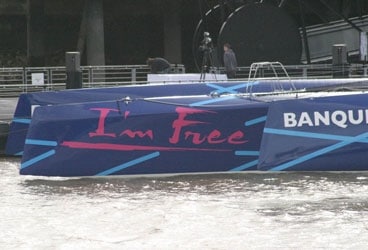
BankPopulaire368b
Banque Populaire, a French bank, invited all comers to the renovated Nantes shipyard waterfront last Saturday to celebrate their 20 years of sponsoring sailing and for the formal christening of the G-class maxi trimaran Banque Populaire V, the largest ocean racing trimaran built to date.
Nantes is the birthplace of Eric Tabarly and Jules Verne and the crowd was also treated to the sight of Eric Tabarly’s five Pen Duicks moored in a row, French Olympians and Olympic-class sailboats, and on the water racing displays by the French sailing federation.
Built to conquer the ocean sailing records such as the Jules Verne around the world record– currently 50d:16h:20m– Banque Populaire V is 131 feet long, with 121-foot amas, a mast height of 154 feet, a maximum draft of 19 feet, and a displacement of 50,690 lbs. The mainsail measures 4,842 sq. ft. and the gennaker, 6,450 sq. ft.
Leading the project is Pascal Bidegorry, a previous winner of the Figaro Solo, and the 60-foot multihull circuit championship. He was named skipper of Banque Populaire IV in 2004 and won the Jacques Vabre in 2005.
In 2006, the sponsor tasked Bidegorry with building a record breaker. A call for design bids went out and the architect office of Marc van Peteghem and Vincent Lauriot-Provost was chosen. Kevin Escoffier headed up the study office, LMV (Cherbourg) built the hulls and floats, Lorima constructed the mast, and CDK Composites manufactured the cross arms and did the final assembly of all the components in a purpose-built shed in Lorient, France.
“I have built plenty of boats but it is the first time I have seen it come together so smoothly in human terms as well as technical,” says Ollivier Bordeau, who oversaw the build. “The bank gave us carte blanche but we didn’t want to surpass that for any eventual build changes.
“In total, it took 18 months, including for calls for bid, six months of studies, and the build. We received designs for three boats, two trimarans and one cat; eventually choosing a trimaran because it would be lighter. [BP V is 13 feet longer than Orange II but 22,000 lbs. lighter.] This is critical for the many weather systems to be encountered.
“There are a lot of embedded measurement systems for the initial verification phase. For example, we wanted to be sure as possible with the Harken winches, which are expected to deal with loads up to 15.4 tons, and also in the different appendages.
“We want to accumulate data for future projects as well. The boat is made up of pre-impregnated carbon, nomex, and cooked four times, at a more elevated temperature (100 deg Cel) than [in many other builds]. The central hull mold was built in an auto clave.
“To assemble all the parts, we used a new system, for the first time in France. We scanned the principal pieces, giving us 1,000 reference points for each section. This assured that the pieces conformed to the architects’ plans. The sections were then reassembled using a computer. It was a very time-consuming process but we were very happy with the results, which allowed precision down to the millimeter. We started assembly with the central hull, then the aft arm, front arm, then one float, then the other.”
Kevin Escoffier, who headed up the research department, further explained about foil development and hull shape: “We spent an enormous amount of time on the foils to make sure they were fast but above all strong. The support boxes for the foils are in titanium because in the event we hit something, we prefer to break away the foil stead of having it fold up like knife blade into the hull. Each float has a curved foil, which follows the hull shape, adding strength, and giving some lift. The small fin works just like on an airplane wing tip. We also purposely designed the bows to be fine and not dig into the waves to avoid pitch poling.”
The boat and crew are now in the discovery phase, focusing on day sails from the team’s base in Lorient, checking systems, and gradually stepping up the program to be ready for their first planned Transatlantic crewed record attempt, the Discovery Route (Cadiz-San Salvador) sometime this coming winter. The time to beat is 7d:10h:58m:53s:, set by Franck Cammas on Groupama 3 in 2007.









